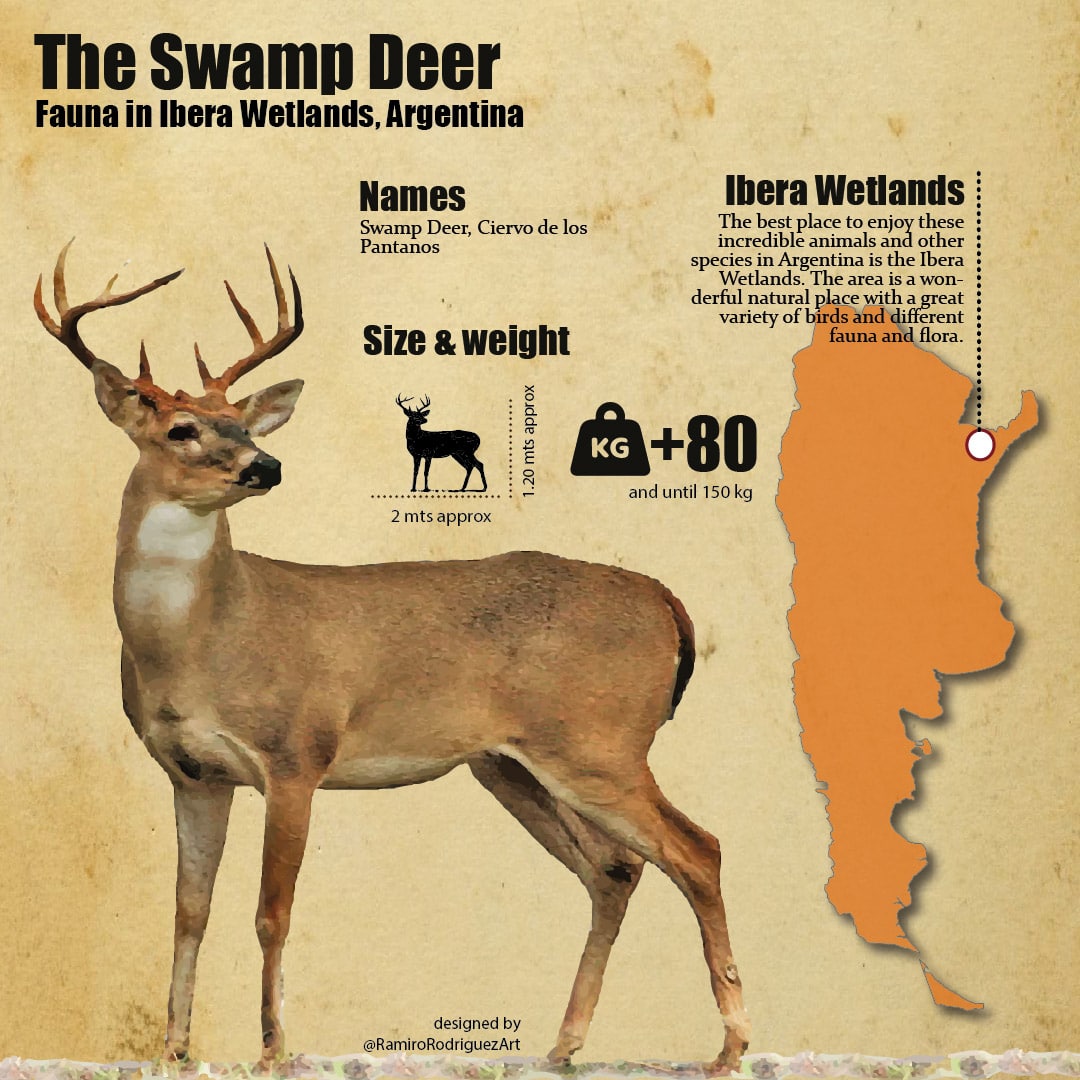What to see in Ibera Wetlands?
Animals in Ibera: The amazing fauna
The Ibera Wetlands are a very natural place, full of a wonderful diversity of fauna and flora. The Esteros del Iberá are a reservoir of stagnant water, with a depth that does not exceed three meters and are covered by aquatic plants. It is constituted as the second-largest wetland in the world: old channels or abandoned beds of the Paraná River make up the base of this complex network of wetlands, which is made up of baths, estuaries, lagoons, reservoirs, and courses of pluvial origin.
Aguapés, poppies and water spangles are some of the floating species that cover the surface of the lagoons, forming camalotales. These give rise to the reservoirs, and the soil that allows the plants to take root is deposited on their vegetal interweaving. Some of these floating islands are up to two meters thick and can be walked on.
Thanks to its peculiar geography, it is one of the areas that has a varied animal population. The native fauna includes numerous threatened species, such as the alligator and the anteater. Therefore, we must be attentive to taking care of this valuable source of water and the species that inhabit it.
But, which animals we can find in Ibera Wetlands? Which species can be seen during my trip? Well, let me detail some of the most representative animals in the Ibera Wetlands.
Fauna in Ibera Wetlands: Amphibians & Reptiles
Amphibians are represented by a significant number of species since the environment full of wetlands is very conducive to their development. The ox or cururú toad (Bufo paracnemis), the common toad also called the gardener toad (Bufo granulosus), several species of the Leptodactilidae family such as the red frog (Leptodactylus fuscus) and the meowing or weeping frog (Physalaemus albonotatus) whose song stand out it is very characteristic. Of the Hylidae family, there are more than ten species present in the area. Among the most conspicuous are the common climbing frog (Hyla pulchella), the small climbing frog (Hyla minuta) and the blacksmith frog (Hyla faber) whose way of reproduction makes it remarkable: it builds a circular mud dam within the wetland where it is found. in whose internal lake it performs the collation, lays the eggs and the tadpoles develop, thus providing optimal protection to their offspring from aquatic predators.
But what´s the group of vertebrate more relevant? Well, the reptils and amphibians. Starting with the aquatic turtles – family Chelidae- the lagoon turtle (Phrynops hilarii), the gutter turtle (Acanthochelys spixii) and the long-necked or river turtle (Hidromedusa tectifera) are common. The Boidae family shows one of its largest representatives as curiyú (Eunectes notaeus) whose length can reach four meters and occupies the appendix II of CITES. Of the Colubridae family there are several species present, among which are the ñacaniná de bañado (Hydrodynastes gigas), the sapera snake (Waglerophis merremii) and the ñuasó (Leptophis ahatulla). Of the Viperidae family, the small yarará (Bothrops newiedii) and the large yarará, crucera or cross viper (Bothrops alternatus) are present. Various lizards also add to the reptile list.
Undoubtedly, the two species of alligator present in the Iberá Wetlands, not only constitute the main representation of the reptile group but of the fauna as a whole due to their compromised status. Indeed, the black alligator (Caimán crocodilos) and the alligator ñato or overo (Caiman latirostris) that occupied. Both species suffered dangerous persecution by hunters for the sale of their coveted leather. In addition, this fauna constitutes one of the greatest attractions for visitors to the place due to the ease with which they can be observed from a boat. The list of the main reptiles in the area ends with the overo lizard (Tupinambis tguixin).
Fauna in Iberá Wetlands: The Caiman Yacare or Yacaré Overo
Some 60 species of reptiles populate the Iberá. The most characteristic for their great abundance are the black alligator (Caiman yacare) and the alligator overo (Caiman latirostris). Both species are the largest predators in the wetland.
There are two subspecies cited in Argentina: Caiman latirostris chacoensis and Caiman latirostris latirostris. The latter is somewhat larger in size, and can exceptionally reach about 3 meters. With a robust body with a particularly heavy head, resulting in its anchovy at the height of the anterior orbital bone edge equal to or even greater than the distance from said edge to the tip of the snout, which appears thick and protruding with dorsal nostrils, but not somewhat strangulated as in C. yacare. Cephalic dermal coatings of irregular plates or escutcheons: strongly granular and rough eyelid, with an upper edentate ridge of bulging tubercles: oval plate or shield in the tympanic region, determined by an extension of the squamous bone, such as in C. yacare. Very evident in both subspecies the large bone and skin relief or “U” crest that extends laterally towards the lips from the anterorbital region. Characteristics of Caiman latirostris chacoensis throughout the range are: the relatively shorter palatal fossae of the skull, contained 2 and ½ to 3 times in the distance between its anterior border and the tip of the premaxillae (unlike C. l latirostris where they are contained between 2 and 2 and ½ times, since they are relatively larger than in the other subspecies); the participation of the pterygoid bones to the palatine fossa, minimal or null in chacoensis, notorious and quite wide in the nominal form.
The diet is made up of birds, fish, and mammals, but in many places, it is a great consumer of snail vectors of Schistosoma, it is, therefore, a very useful element in tropical biocenoses. Also due to the solidity of their jaws, it suggests a dietary component of crustaceans and perhaps aquatic turtles. Gastroliths are usually found in your stomach. The biology and ecology of this caiman deserve further study, but the destruction to which it has been irrationally subjected in recent decades raises serious questions about its possibility of survival. Nesting occurs in accumulations of organic remains where 40-50 eggs are deposited in each position. Development may need no more than 5-6 weeks. The specific name alludes to the respectable width of the head of this reptile. C. l. latirostris would be broadly similar, but its habits would be more nocturnal and strictly aquatic: its behavior would be more aggressive.

Fauna in Ibera Wetlands: Mammals
Among the most conspicuous mammals of the Esteros is the capybara (Hidrochaeris hidrochaeris), whose precious skin had also made it one of the preferred prey by shellfish, the river wolf (Lontra longicaudis) The capibara called Carpincho, was declared a Natural Monument by the Legislature of the Province of Corrientes. From the point of view of conservation, one of the most important mammals is the marsh deer or guazú-pucú in Guarani Language (Ciervo de los Pantanos in Spanish), (Blastocerus dichotomus), and declared Natural Monument for the provinces of Corrientes; Chaco and Buenos Aires. This deer finds in the Esteros del Iberá the protected area that houses the largest population and exceptional habitat conditions, moving with sufficient skill between flooded areas covered by grasslands. Another deer present is the guazuncho, guazú birá or brown bark (Manzana govazoubira.). A small population of deer or pampas deer (Ozotoceros bezoarticus) is located in the fields of a ranch in the area.
Among the canids, the star is the maned guazú or maned wolf (Chrysocyon brachyurus), also prepared for its height to walk among grasslands. He is accompanied in the same family by the mountain fox (Cerdocyon thousand). Felines have three species, two of which are relatively conspicuous and one is very rare. The first two are the common wildcat (Oncifelis geoffroyi), with Potentially vulnerable status, the Moorish or yaguarundi cat (Herpailurus yaguarondi), and the ocelot. and ounce cat (Leopardus pardalis), very rare, whose distribution includes the north of Corrientes. Also noteworthy is the presence in the area of the howler monkey (Alouatta caraya).
It is possible to observe two species: the large mullet or black tatú (Dasypus novemcinctus) and the small mullet (Dasypus septemcincus). It is also possible to see the mayuato, aguará pope or washing bear (Procyon cancrivorus), the folkloric vizcacha (Lagsotomus maximus), the lesser ferret (Galictis cuja) and the conspicuous common skunk (Conepatus chinga). Marsupials include the red weasel (Lureolina crassicaudata) and the common overa (Didelphys albiventis) and several species of bats such as the common vampire (Desmodus rotundus), the black bats (Myotis nigricans) and rats and mice of the Muridae family. they complete the Iberá mastofauna.
Fauna in Ibera Wetlands: The Capibara or Carpincho
In general, capybaras are animals that prefer to carry out their activities at twilight hours. They enjoy staying in the water for a long time and are commonly found near bogs where they can moisturize their skin, as some pieces are exposed, without their characteristic reddish fur.
For their part, capybara hatchlings are remarkably precocious in their search for resources. Within moments of being born, they are able to identify and follow their mothers for nutritious herbs to eat. By 15 months of age, they have reached puberty and can lead lives of 10 years on average. In addition to always getting along with a great diversity of animals, capybaras are never alone. In general, they are found with their peers, in large groups of up to 20 specimens. Despite this, they are generally sighted with members of their own families, since if an alien capybara approaches, it may not be welcome.
The capybara, capybara or chigüire, is a rodent of the cavidae family. It is the largest and heaviest living rodent in the world. It lives in the terrestrial zone of the tropical and temperate forests and savannas of central and southern South America up to almost 2,000 m a.s.l. In Argentina, it is found on the coast, in the provinces of Entre Rios and Corrientes, in the Esteros del Iberá. It is related to agoutis, chinchillas, nutria, and guinea pigs

Fauna in Ibera Wetlands: The Swamp Deer or Ciervo de los Pantanos
The swamp deer or Ciervo de los Pantanos, is the largest deer in South America and in our country, it is found mainly in the Esteros del Iberá (Corrientes), and in the Paraná delta (Buenos Aires and Entre Ríos), where it is a symbol of culture. It is one of the few amphibian cervids in the world, a characteristic that it only shares with the barasingha of India and Nepal, and the water deer of China, which makes it a particularly unique specimen.
Adults weigh about 150 kilograms. They can reach about 2 meters from head to tail and a height of up to 1.30 meters at the withers. They have reddish-brown and black fur on their legs. Males develop large antlers and, like all deer, their antlers drop each year. The destruction of their habitat and hunting are the main threats facing their populations. At the international level, it is classified as a vulnerable species in the Red Book of the International Union for the Conservation of Nature, while in Argentina it is classified as in danger of extinction.
The swamp deer was declared a Natural Monument in the provinces of Chaco, Corrientes, Buenos Aires and Entre Ríos. Mainly in the Paraná delta is where the decrease in the number of individuals, in the last years of the 20th century and the first of the 21st, was greater, as a result of hunting and changes in land use.

Fauna in the Ibera Wetlands: The River Otter or Lobito de Rio
The river Otter (Lontra longicaudis), called in Spanish Lobito de Rio, also known as the northwestern otter, neotropical otter, water dog (llanos of Colombia and Venezuela), pisua or mallu-puma, is a mustelid of the Lutrinae subfamily, found in Central and South America, from southern Mexico to Uruguay and central Argentina.
It measures between 50 and 130 cm in length and weighs between 5 and 12 kg; males are 20-25% larger than females. The coat is brown, cinnamon to grayish. The nose is black. The legs are relatively short and have strong claws with robust nails and webbing. The conical tail ends in a point.
The River Otter or Lobito de Rio lives in different riparian habitats, including deciduous and evergreen forests, savannas, plains, and swamps. It is possible that this species prefers clearings, rivers and mountain streams up to 3000 meters above sea level and is less frequent on flat terrain. They are both diurnal and nocturnal solitary. They basically feed on fish and crustaceans. The Lobito de Rio or Lontra longicaudis platensis was declared a natural monument by the province of Corrientes in Argentina

Fauna in Ibera Wetlands: The Aguara-guazu
The Aguará-guazú (Chrysocyon brachyurus), in Guaraní means “big fox”, is, as its name implies, the largest of the South American foxes. Also known as the maned wolf or foal, it is omnivorous and represents, for some native cultures, such as the Tobas and Mocovíes, a sacred animal shrouded in spirituality.
With a presence in the provinces of Corrientes, Formosa, Chaco, north of Santa Fe and Córdoba, east of Santiago del Estero, and south of Misiones, the aguará guazú is nationally cataloged as a threatened species and is included in different conservation programs and policies of wildlife.
The Aguara-guazu has a rather long coat, red in color, and on the nape and crosses it has a kind of dark mane. It is omnivore and opportunistically hunts rats, armadillos, guinea pigs, birds, other small vertebrates, and insects, supplementing its diet with wild fruits. The female attracts the male through vocalizations. Gestation lasts from 62 to 66 days, with litters consisting of 1 to 5 young (mostly 2).
Weight: 20 to 30 with some that reached 34 kg. approximately Appearance: It is similar to the fox, with an elongated head, long reddish-orange hair, with a long collar of fur around the neck and black color on the face, back and legs. Character: Shy, suspicious, lonely. Harmless to humans.

Fauna in the Ibera Wetlands: The birds
The birds are very numerous in species, highlighting those linked to the aquatic environment due to the environmental characteristics of the reserve. Among these there are several species of ducks such as the red sirirí (Dendrocygna bicolor) or the black-bellied sirirí (Dendrocygna autumnalis), rare, the crested duck (Sarkidiornis melanotos) and the muscovy duck (Cairina moschata). Another family of aquatic habits with many species is that of the herons, of which we can observe the red hocó (Tigrisoma lineatum), the little conspicuous mirasol grande (Botaurus pinnatus) and small mirasol (Ixobrychus exilis) and several other species. The three species of storks that inhabit Argentine territory are present in Iberá: American stork or tuyango (Ciconia maguari), the yabirú (Jabiru mycteria) and the tuyuyú (Mycteria americana).
Other species of aquatic habits are the aguatero (Nycticryphes semicollaris), the painted pullet (Porphyriops melanops), the batitú (Bartramia longicauda) categorized with low Irrigation status, the common burrito (Laterallus melanophaius), the atí (Phaetusa simplex) and many more than they would make a long list. Among the birds of prey, we must mention the presence of the lobster harrier (Buteo swainsoni), the peregrine falcon (Falco peregrinus), the red harrier (Heterospizias meridionalis) , the ashen hawk (Circus cinereus), the common esparvero (Accipiter striatus) and the black eagle (Buteogallus urubitinga) among some thirty species of this group that can be observed in the great surfaces of the Esteros del Iberá. Several parrots make up the winged cast such as the ñanday (Nandayus nenday), the dwarf catita (Forphus xanthopterygius) and the conspicuous talking parrot (Amazona aestiva) with low-watering status, despite being one of the most sought-after and widespread parrots as a pet.
The pigeons – Columbidae – are in the region with at least six species, the hummingbirds – Trochiliidae – with four and the woodpeckers – Picidae – with approximately nine species. Three species of kingfisher are patiently on their perch looking out into the water on the lookout for a minnow. You can also see beautiful birds such as the common surucuá (Trogon surrucura), the large toucan (Ramphastos toco), the white widow (Fluvicola pica), the red picapalo (Campylorhamphus trichilirostris) with its huge bent beak, the common tangara (Euphonia clorotica ), the yellow thrush (Xanthopsar flavus) considered Vulnerable and rare in the reserve, the seven-dressed (Poospiza nigrorufa) and many more.
Fauna in Ibera Wetlands: Fish species
The fauna of the Iberá Nature Reserve is very important. The ichthyofauna is made up of a significant number of species, for example the dorado or pirá-yú (Salminus maxillosis), the tararira or tarucha (Hoplias malabaricus), the boga (Leporinus obtusidens), several mojarras (Astianax sp.) and many more species belonging to different families.
Tours to visit Ibera Wetlands
We have some great tours to visit Ibera Wetlands. You can check for example our 161 tour called Buenos Aires, Ibera Wetlands and Iguazu Falls, in a wonderful 9-night itinerary to enjoy the best of the nature in Argentinian Northeast
Tours to visit Ibera Wetlands and other destinations in Argentina
We have a wide variety of tours to visit the best of Argentina, including Ibera Wetlands and many other amazing destinations. Check our complete list of tours to visit Argentina
For more information, just contact us at info@ripioturismo.com
Thank you!














